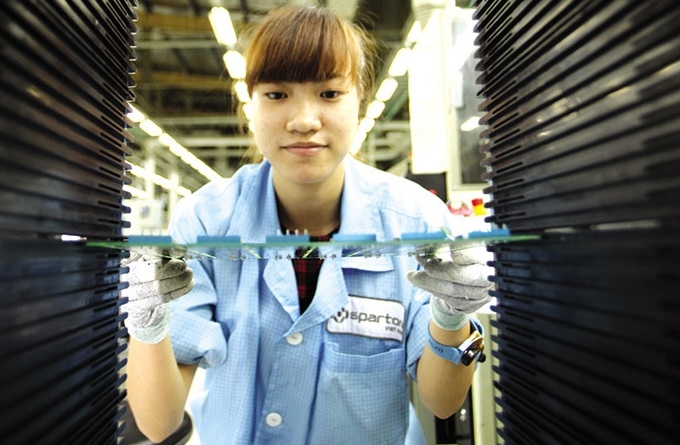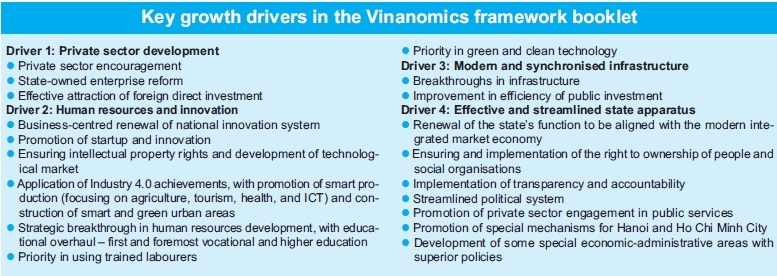Linking business for optimum gain
 |
| An effective link with foreign enterprises will help improve local firms’ competitiveness, Photo: Le Toan |
Christopher Malone, partner and managing director at the Ho Chi Minh City Office for American management consulting firm Boston Consulting Group Inc., expressed admiration for the recently debuting VinFast project to manufacture automobiles and motorbikes.
VinFast, an arm of Vietnam’s largest conglomerate Vingroup, is set to become the leading car manufacturer in Southeast Asia, with a designed capacity of up to 500,000 cars and one million electric motorcycles at its manufacturing complex by 2025.
To develop this $1.5 billion project, VinFast acquired intellectual property licences from world-famous brands like Pininfarina, BMW, Magna Steyr, AVL, Siemens, and Bosch.
“This project is typical of Vietnamese businesses effectively co-operating with foreign partners,” Malone said at last week’s Vietnam Reform and Development Forum in Hanoi.
He underlined nine factors driving Industry 4.0 which included advanced robots, augmented reality, cyber-security, and analytics.
“One of the solutions to ensure these is to develop privately owned enterprises (POEs) as a driving force for the economy, and facilitate them to co-operate with foreign-invested enterprises (FIEs). This could create a good spillover effect for the entire economy,” Malone said.
NEW MOMENTUM
At the forum, aimed at seeking out new momentum for the economy via reforms, the World Bank and the Vietnamese government launched Vinanomics, a booklet about the economic policy framework of the country. It features development orientations for Vietnam until 2035 with key priorities, one of which is development of POEs, with a boost for these enterprises to link with FIEs. This development will contribute to helping Vietnam grow by an estimated average 6.85 per cent during 2018-2020.
Prime Minister Nguyen Xuan Phuc stressed at the forum, the first of its series to be hosted annually by the government, the urgent need to boost the development of POEs. “The private sector is one of the drivers of the economy. It can create huge competitiveness and flexibility for the economy in the context of strong global development,” he noted. “The government has always attached great importance and taken concrete actions to develop the private sector so that by 2020 we will have around one million enterprises, with the majority being POEs.”
When placing the private sector at the top of his proposals to the government last week, Ousmane Dione, country director of the World Bank in Vietnam, said, “Reforms to promote domestic private sector development will need to be significantly stepped up, making it a primary driver for improved productivity and growth. This entails continued efforts to remove obstacles to private business and strengthen regulatory environment.”
Having studied Vietnam’s economy for years, Richard D. McClellan, senior advisor from McKinsey & Company Vietnam, sees that the private sector must be a new growth momentum for Vietnam now, as the country has almost completely missed the opportunity to develop POEs over the past 25 years, while foreign direct investment (FDI) has been growing steadily. McClellan said, “The private sector in mature economies can be as high as 80-90 per cent of the GDP. In Vietnam, the formal private sector accounts for less than 10 per cent. However, the informal private sector (household) accounts for one third, putting the total private sector at 42 per cent.” “However, over the last 25 years this has remained constant, with the mix shifting slightly toward the formal sector,” he stressed. “Opportunity is therefore three-fold, including accelerating the transition from informal to formal economy, reducing the favoured position of state-owned enterprises (SOEs) in the economy, and strengthening the ecosystem around FDI.”
 |
BUILDING A LINK WITH FIES
According to the Ministry of Science and Technology (MoST), a number of big Vietnamese companies like VinFast have co-operated with FIEs, but it is only “a grain of sand in the desert.” Though Vietnam has attracted tens of thousands of foreign-invested projects over the past 30 years, technology transfer to domestic businesses has been limited.
“The transfer has failed to meet expectations,” stressed MoST Deputy Minister Tran Van Tung. “The technological spillover effect remains limited. Only domestic businesses transfer tech to one another.”
According to the Central Institute for Economic Management’s (CIEM) recent report on business-level technology and competitiveness in Vietnam compiled from five surveys over 38,731 POEs and FIEs, technology advancements usually came from domestic businesses. Over 80 per cent of transfers took place between Vietnamese businesses.
FIEs in similar sectors have been responsible for just below 20 per cent of technology transfer to domestic counterparts.
“Overall, technology transfer primarily takes place among domestic businesses in Vietnam, suggesting that FDI may not be as effective for technological advancement as believed,” said CIEM’s deputy director Nguyen Thi Tue Anh. “Many domestic businesses still fail to link with FIEs, though FIEs continue expanding in size.”
According to Shinjiro Kajikawa, representative of a Japanese car maker in Vietnam, one of the biggest barriers for FIEs in Vietnam is the high cost of localisation.
“If a part is cheaper in Vietnam than in Thailand, including import tax and logistics, it can be localised,” Kajikawa said. “Otherwise, makers have to import these parts. In Vietnam, due to the small volume, the majority of completely-knocked-down (CKD) parts are imported. That’s one of the reasons why Vietnamese businesses cannot learn much from FIEs.”
WORDS OF WISDOM
According to McClellan from Mckinsey & Company Vietnam, the government needs to make it easier to start and grow a business. Examples include simplifying tax and administrative procedures; improving access to capital, land, and government contracts; and strengthening market institutions such as corporate governance, fostering competition, property rights, and land markets.
For Dione of the World Bank, in order to foster the private sector and link them with FIEs, Vietnam needs to speed up SOE reforms, with a focus on the adoption of international best practices in governance, including through the newly established SOE management committee, while accelerating and deepening equitisation and divestment, especially from commercial assets. “FDI attraction should also shift away from quantity to quality with a focus on high-tech and high value-added investments with technology transfer to harness stronger links between businesses. This would ultimately help the domestic private sector effectively join global value chains,” Dione suggested.
In the view of Malone from Boston Consulting Group, Vietnam is still a small economy trailing behind other nations in terms of technology and innovation. He cited the World Economic Forum readiness report 2018 stating that Vietnam ranked 45th in economic size and 90th in technology and innovation globally. “Vietnamese businesses are not yet ready to adopt Industry 4.0 technologies. In addition to developing POEs, Vietnam needs a new network of innovation hubs focusing on the advantage of its location,” Malone said.
In response to the proposals, PM Phuc stressed that the government is focusing on improving the quality of human resources. “The government considers human resources a golden key to the country’s future success, and is actively seeking solutions to develop high-quality human resources in service of sustainable development,” he said. “Currently, only 40 per cent of Vietnamese labourers are trained, and Vietnam is listed among nations not yet ready for Industry 4.0. Humans and technology are both the key and the lock, which must be compatible. A 4.0 industry will become insignificant without 4.0 people.”
What the stars mean:
★ Poor ★ ★ Promising ★★★ Good ★★★★ Very good ★★★★★ Exceptional
 Tag:
Tag:
Related Contents
Latest News
More News
- Cake by VPBank posts strong gains in scale and efficiency leveraging AI focus (January 05, 2026 | 18:55)
- Vietnam's retail market tops $269 billion in 2025 amid e-commerce boom (December 31, 2025 | 19:00)
- Global alliance develops $1 billion AI data centre network in Vietnam (December 30, 2025 | 10:08)
- Businesses ramp up production as year-end orders surge (December 30, 2025 | 10:05)
- Vietnam’s GDP forecast to grow by 9 per cent in 2026 (December 29, 2025 | 08:29)
- Vietnam's top 500 value-creating enterprises announced (December 27, 2025 | 08:00)
- Three-way partnership unveiled to ease financing at Hong Hac City (December 24, 2025 | 14:13)
- PM orders investment model for North–South high-speed rail (December 22, 2025 | 17:43)
- First members of Danang International Finance Centre revealed (December 22, 2025 | 17:39)
- Securing capital and efficiency for Vietnam’s 2026-2030 growth ambitions (December 17, 2025 | 10:00)























 Mobile Version
Mobile Version